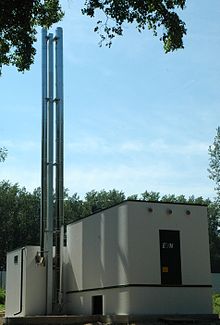Prefabricated part
Finished parts are prefabricated components made from raw materials or semi-finished products that can be used in an end product without further processing. For example, roof tiles or windows are delivered to construction sites as prefabricated parts so that they can be used immediately.
properties
Basically, two different types of prefabricated parts can be distinguished. Standardized mass products are manufactured in indefinite quantities and, thanks to their standardized properties, can be used in many end products. Examples are capacitors in the electrical industry or manhole covers . The aim is to reduce the costs of the individual element through the high number of components produced.
Finished parts can, however, also be produced as individual pieces. Smaller truss bridges in industrial halls are welded together from individual tubes and delivered as a whole to their destination. As a result, a higher quality can be achieved through prefabrication, since individual elements are joined together under controlled conditions in the factory and not in the open air. Furthermore, the construction time is shortened and thus the costs are reduced. For comparable reasons, segments of large prestressed concrete bridges and parts of entire steel bridges are prefabricated.
Historical development
Bricks were one of the first prefabricated parts that humans produced . Certain wood cross-sections such as boards and battens as well as pipes and panels of various materials are also among the earliest prefabricated parts. Smaller standardized components such as nails or screws were also manufactured industrially early on, but are not referred to as prefabricated parts in everyday language.
Frequently required prefabricated parts in the building industry include roof and hollow tiles , formwork stones , steel girders , overlays , insulating material and a wide variety of preliminary products for windows and doors. Important sectors with a high percentage of prefabricated parts are also interior fittings and furniture construction as well as the mechanical engineering and electrical industries .
In the case of more complex construction methods, the precast industry reached a climax with the development of prefabricated houses and steel construction , with the methods of composite and assembly construction and, on a smaller scale, in communications technology and electronics .
Overview of common precast parts (selection)
General
- Precast concrete part , artificial stone , sintered products
- Metal construction , prefabricated construction , panel construction , shell construction,
- Wire , nails , screws , reinforcing wire etc.
- Profile steel , profiled wood , rubber and plastic profiles
Important precast parts in building construction
- Bricks: solid bricks , hollow bricks , formwork bricks , roof tiles
- Statics: Building profiles , wall panels , truss , floor slab , steel beams , overstock , finished fall ,
- Prefabricated building: prefabricated bathroom , prefabricated garage , prefabricated parquet , prefabricated ceiling ,
- Interior construction: insulating material , prefabricated screed , impact sound panels , tiles , clinker , plasterboard , chipboard , windows and doors (wood, plastic, metal)
- Exterior works: boundary stones , concrete slabs , plastic pipes , gabion ...
- further finished mixtures (finished, ready-mixed concrete , finished plaster, foaming, grout, etc.)
Prefabricated parts in road construction
- Precast concrete part , concrete slabs ,
- Boundary stones and curbs ,
- Concrete safety barrier , crash barriers , ...
Prefabricated parts in civil engineering and tunnel construction
- Concrete slabs , scarf stones , pilot
- Reinforcement , steel anchors , tubbings ,
- Measurement technology , strain gauges ,
Timber construction and furniture construction
- Truss , rafters , girders , cardboard boxes , plasterboard ,
- standardized boards , profiled timber, etc.
- Chipboard , veneers , fittings , ...
Prefabricated parts made of ceramic
- Sintered products , insulators , ...
Finished parts in mechanical engineering
- Semi-finished products : steel pipes , sheets , steel girders , steel girders
- Machine elements : screws, rivets , axles , bearing shells , ball bearings
- Castings , forgings , finished castings , sintered products
Finished parts in the electrical industry
- Capacitor , resistor , circuit board , ...
- Insulators , power cables , concrete mast ,
See also
- Construction element (construction) , cantilever
- Program production , mass production , type production , production order , production costs
- to water
- Prefabricated concrete garage


